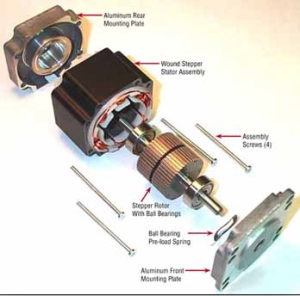Why does HobbyCNC use unipolar stepper motors?
And what is the difference between bipolar and unipolar stepper motors? Is one better than the other? Let’s start with the differences between the two types of motors*.

Stepper Motor Exploded View
(Source: http://jssmotor.en.made-in-china.com/product/rvkmWoRMZIcB/China-2-Phase-1-8-Degree-NEMA-34-Stepper-Motor-86HS118-6004A-.html)
A unipolar motor works from a single polarity on each coil. These require simpler electronics to drive. However, they require two pairs of windings, wired in reverse of each other. To oversimplify, power one coil and the magnet is North-South. Power the other coil and the magnet is now South-North. (or “suck” and “blow” as one of my college instructors used to say). Unipolar motors have 5, 6 or 8 wires. More wires = more complexity to connect. Not substantial, but more complex compared to 4 wires.
A bipolar motor has just a single pair of windings, and the electronics to drive them must be able to switch polarity, typically with an “H bridge” driver circuit. Since the motor has only one pair (two) windings rather than two pairs (4 windings), a bipolar motor of the same weight could theoretically have more power. Bipolar motors typically have 4 wires and are therefore less complex to connect.
Cost-wise both motors are similar. The bulk of a motors weight comes from the body (stator assembly) and the rotor, not the wiring.
So, why does HobbyCNC use unipolar stepper motors?
Well, it’s not really about the motors. It’s about the driver chip (Allegro Microsystems SLA7078MPR). It is a mature, robust, easily ‘heat-sinkable’, durable driver chip. It has built-in short-circuit protection. It is a very reliable chip. It is priced very well for the hobby CNC market and helps us keep the cost down. It is also easily soldered, which is important since we only sell kits. We have been using this chip for many, many years, in 1000’s of boards, with outstanding success.
And, from a practical standpoint, 8 wires isn’t all that complex to handle. Really.
To learn a bit more, there is an excellent article on Adafruit.com with drawings and great images.
* This is not meant to be a complete tutorial on stepper motors. There are many types and designs of motors, many sizes and many price ranges. This description is kept basic for common, simple stepper motors to be used for hobby-level machines.
